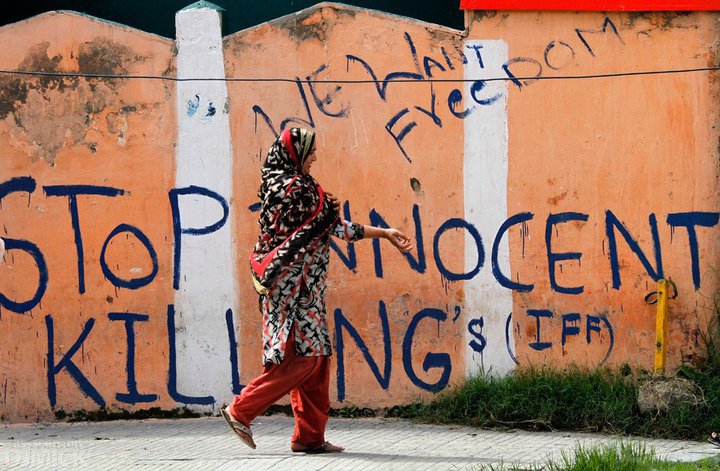
On 8 October Shah Faesal, a key civil servant in charge of education in Kashmir, wrote on his Facebook timeline: “I am Director of shut schools. I need a job” - an appeal for schools to re- open in Kashmir Valley.
His post invited mixed comments. Some were scathing, admonishing the government for reflecting people’s sentiments about the situation in Kashmir, others urging to keep children out of the political ambit.
On 11 October, daily newspaper the Greater Kashmir published Two parables and a condemned man, an open letter by Education Minister Naeem Akhtar to Syed Ali Shah Geelani, a separatist leader spearheading the violent ‘azadi’ movement backed by Hizbul Mujahidin. The movement is considered a terror group by the US, EU and India. The letter called upon the ‘resistance leader’ to stop denying Kashmiri children their right to education.
Clashes in Kashmir
It his more than three months since schools, business establishments, offices and public transport have been shut after Burhan Wani, a terrorist of Hizbul Mujahideen, was shot dead in July. News of his death erupted into spontaneous, anarchic violence which spread throughout Kashmir. This evoked a brutal and unsparing response from the police and paramilitary forces. When frenzied mobs and militants took the levels of violence to a new ferocious high, it was met with more aggression from the government.
Pellet guns used against mobs of teenagers hurling stones, petrol bombs and other objects engaging in violent duels resulted in scores of youth being partially or permanently blinded, impaired, disabled and injured. The vicious cycle of anger and brutality led to curfews, deaths and destruction. There have been around 95 deaths, including of policemen, and thousands of injuries on both sides. Buildings, public transport and schools have been burnt, cars smashed to pieces. Almost 35 government schools have been burnt down, and hundreds have been put behind bars under stringent laws.
“Where are we heading to?” asks Nargees, the mother of a six year old in Srinagar.
Cautioning Kashmiri society against adding their voices to the misplaced azadi youth agenda, she makes a pitch for rationality and peace: “We are breeding notoriety among our children with street power, and destroying Kashmir’s future if we support the way this struggle is being led,” she adds ruefully.
The majority, however, are angry with the way the government has responded to the uprising.
“We also do not support the idea that schools should be closed but let this be the final call so that there are no more deaths,” says Javed, a special needs school founder.
“But this is a mentality that is using child’s agency for political goals,” says Nargees.
Kashmir is caught between the extremists, the moderates and the escapists.
Violence – the great leveler?
Common people are fed up of the violence by both sides. They feel wounded and pained by innocent killings. Ironically, the same voices dry out, perhaps out of fear, when elected representatives, grassroots workers or policemen are killed - who are also Kashmiri.
“Human rights violations and deaths favour the separatists,” says a local journalist. As such, street violence, terror by terrorist groups, religious driven ideology and public sentiment become an ideal, lethal combination for separatists to secure and wrestle street power from elected representatives, thereby dominating and controlling the agenda. This is how the ‘United Resistance Leadership’, an all separatist constituency in Kashmir, have been able to overshadow the elected representatives of People’s Democratic Party headed by the Chief Minister Mehbooba Mufti.
“Nobody seems to be listening to the appeals of government for peace and stability. The separatists are running a parallel government. Their interest is not in dialogue. Their interest is in closing all doors so that violence rules. It is humanity and people that loose in the end. The absence of any dialogue suits and favours extremists,” added the journalist.
Brokering peace from the ground up
To broker lasting peace in Jammu and Kashmir, a three track process must be started. This should initiate a public, humanitarian process to include an honest and truthful dialogue between all stakeholders.
This is a dialogue that has never begun. But it is the only thing that can bring out all the discerning voices in the region. The dialogue is crucial, but is it possible in such a situation of hurt and pain on all sides?
With this idea in mind, more than 10 community organisations met in Srinagar in August on conditions of anonymity to listen to each other. They met in the middle of a hostile environment, with fear of community ostracisation and backlash. The aim: to break the deadlock, bring together conflicting views.
This was a small but courageous step to break the deadlock. This circle of dialogue has to be widened, expanded and deepened to bring in representatives from Jammu and Ladakh.
These conversations - held across the faultlines of ideologies, political positions, aspirations and experiences of people, their perceptions of history and the end goal - need to be opened. Multiple stakeholder dialogues have to be held at multiple levels to build a synergy for any peaceful solution.
“Violence can never be the way forward. Those forces that manufacture hate have to be defeated by educating, sensitizing and listening to each other” says Indu Kilam, an educator and social activist.
In today’s Kashmir, democratic institutions and alternate voices have been replaced by religious institutions and virulent voices of aggression. Social and community organisations are doubted and labeled. While doors of dialogue and windows of mind need to be opened, Kashmir continues to burn. It awaits a leader and the collective will of the people to pull Kashmir out of this quagmire.








